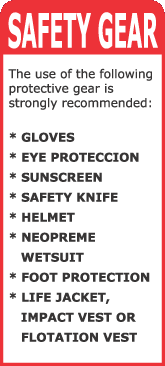
| HOME | WINDSURFPERU | BIC SPORTS | WIND SPOTS | GALLERY | 4 SALE | RENTAL | SCHOOL | RIDERS | LINKS | SAFETY | CONTACT US |
 |
|
||||||||||||||||||||||||||||||||||
Wind, Water and Weather Conditions
 |
|
Know your ability level
Do not attempt kiteboarding without appropiate instrucction. |
Do not kite alone. | ||||||||||
Never kiteboard further from shore than you are able to swim back.
|
Make sure the water conditions are within your ability level and that you have made the correct equipment choices. |
||||||||||
Launch, land and ride together with a partner or have someone on shore who can keep an eye on you.
|
Always save a reserve of energy; end your kiteboarding session before you are exausted. |
||||||||||
Make sure you are in good physical condition before using this product. |
Make sure you've done your homework and that you know the safety precautions of all aspects of the sport: launching, landing, flying, riding, kiting among other water users, self rescuing, etc. |
||||||||||
Practice flying a small, traction kite or a "triner kite" before flying this kite. |
Understand the tecnique of self-recue before using this product in or near the water. |
||||||||||
The more time spent on this "triner kite", the safer and the faster you will learn. |
Never let someone who is not familiar with inflatable kites launch, catch or use your kite. You will endanger them, as well as yourself and those around you. |
||||||||||
Make sure you are a proficient swimmer before using this product in or near the water. |
You are responsible for the safe operation of your kite. |

Kiteboarding Location
Observe local laws and regulations regarding this product and the usage area. |
Avoid launching, landing or using this productnear power lines, telephone poles, trees, peolple, pets, buildings, automobiles, streets, sharp objects, downwind and airports. |
|||||||||
Talk to the local riders about the weather conditions and beach rules.
|
Always save a reserve of energy; end your kiteboarding session before you are exausted. |
|||||||||
Check your area thoroughly before launching your kite.
|
Avoid crowded beaches and waterways.
|
|||||||||
Make sure you have considerable space to launch, land and use this product. |
Make sure your power lines do not crossa walk-way or passage. |
|||||||||
You should have at least a 100 meters of space onboth sides and downwind of you. Be specially aware of your downwind area. |
Be careful and mindful of other water users, including windsurfers, boaters, jet-skiers, swimmers, floating objects, etc. |
|||||||||
Be mindful and aware of the wind direction in relation to wour launch area. |
Before launching, make sure you have scouted a safe landing area, in case you do not make it back to your launch spot. |
|||||||||
Avoid areas with rocks and/or shallow or exposed reefs. |
Do not let others between you and your kite. |